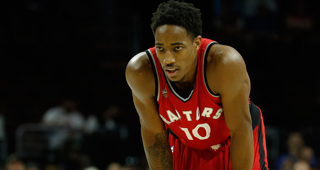The Toronto Raptors have a DeMar DeRozan problem. As their second-best player, a two-time All-Star and steadily improving source of offense, the 26-year-old can’t seem to put it all together in games that actually matter.
Coming off the best regular season of his career, averaging 23.5 points (ninth highest in the league) with a shiny 21.5 PER, DeRozan’s Game 1 performance against the Indiana Pacers was a dud, stitched from the same disturbing pattern that began two years ago.
DeRozan needed 19 shots to score just 14 points on Saturday. Paul George (who dropped a game-high 33 points on one end and supplied first-team All-Defense effort on the other) led his Indiana Pacers to a 10-point win, upsetting the Eastern Conference’s two seed on their home court.
Toronto was outscored by 15.3 points per 100 possessions with DeRozan on the floor. Only three of his shots came in the restricted area, he managed six free throws and 14 attempts were contested. By the second half, his confidence had all but evaporated whenever he saw George’s face:

Nothing about this was all that strange, being that the Raptors were swept by the Washington Wizards last year and fell to the 890-year-old Brooklyn Nets the year before that. DeRozan’s shortcomings annually cast a fishnet that his team can’t swim through; they held home-court advantage in both those match-ups, but DeRozan shot just 39.1 percent.
He didn’t finish around the basket, and consistently settled for the type of contested mid-range pull ups that strangle Toronto’s rhythm and short-circuit its collective efficiency.
But this year was supposed to be different. Nobody attempted more two-point field goals than DeRozan in 2015-16, and (arguably) nobody was more effective driving to the basket. He spent his seventh season cementing himself as more than a dynamic slasher, instead evolving into a multi-dimensional playmaker who lifted teammates as well as himself. He was reliable on a nightly basis, with the highest usage percentage on the team by a fairly wide margin—a group that held the fifth-best offense in the NBA. Last year, DeRozan ranked 30th among shooting guards in Real Plus-Minus. This year, he was fifth.
To get back in the series and, heaven forbid, resume its status as a pseudo-contender, Toronto needs DeRozan to hit shots and start resembling the efficient monster he’s become.
One simple way Dwane Casey can make life easier for DeRozan: play him with Patrick Patterson. During the regular season, DeRozan was 4.1 percent more accurate in the restricted area with Patterson on the court, and more of his offense came from mid-range jumpers when Patterson wasn’t on the floor.
On a grander level, the Raptors’ offense rating was 104.7 when DeRozan didn’t have Patterson by his side and 110.7 when he did. In Game 1, the difference was astronomical. It’s all about spacing. Have Patterson set screens/run handoffs for DeRozan and watch how uncomfortable it makes defenders who have to worry about the stretch four popping out for an open three.

In the play above, DeRozan is able to attack a retreating C.J. Miles after he zooms off the edge to take Patterson’s handoff. The trailing George doesn’t fully commit to contesting DeRozan’s shot, and instead falls back at the last second after realizing Patterson is wide open on the perimeter. (According to NBA.com’s new hustle stats, Patterson had three “screen assists” in Game 1, which are when a teammate scores directly off a pick set by one of his teammates.)
Luis Scola has been Toronto’s starting power forward for the entire season, but it may make sense to change things up from the opening tip, especially if the Pacers continue to plug two traditional bigs in their starting lineup. This may hurt Toronto’s depth, and, as the favorite, there’s no reason to make a big lineup change after only one game. But it’s definitely something to consider if they lose Game 2.
Another way to get DeRozan going? Let him thrive against Indiana’s inferior one-on-one defenders. Sometimes that means setting a high screen and letting him flow downhill. Sometimes it means getting creative, and really opening up room by screening the screener’s man, as Norm Powell does below:

But there are more simple ways to free DeRozan, and minute distribution is one. DeRozan didn’t get a single shot off when he and George did not share the floor in Game 1. That’s a problem.
The Pacers are a one-man team. They can’t win unless their star plays extremely well. George will be on the floor a ton, but when he rests, DeRozan needs to be out there. That may mean Casey pulls him six minutes into the first quarter, then starts him in the second with a bench mob (Patterson, Terrence Ross, Cory Joseph and Bismack Biyombo) that’s been destroying opponents all year long.
Then do the same thing in the third quarter, so DeRozan has 8-10 minutes to attack someone like Rodney Stuckey. Stagger his minutes, let DeMarre Carroll fill in those late first and third-quarter gaps and see what happens.
The Raptors probably have three of the four best players in this series, but they won’t win unless they show it, starting with DeRozan. If he continues to play this poorly, the Raptors may not have to worry about another organization leaping out of their seat to offer him a max contract. Then again, if he can’t make a positive difference in the playoffs, Toronto may not want to throw that money his way, either.
This is a very big series for a franchise that’s scratching to join the league’s elite. Now is the time to show they belong; nobody needs to come up big more than DeMar DeRozan.



